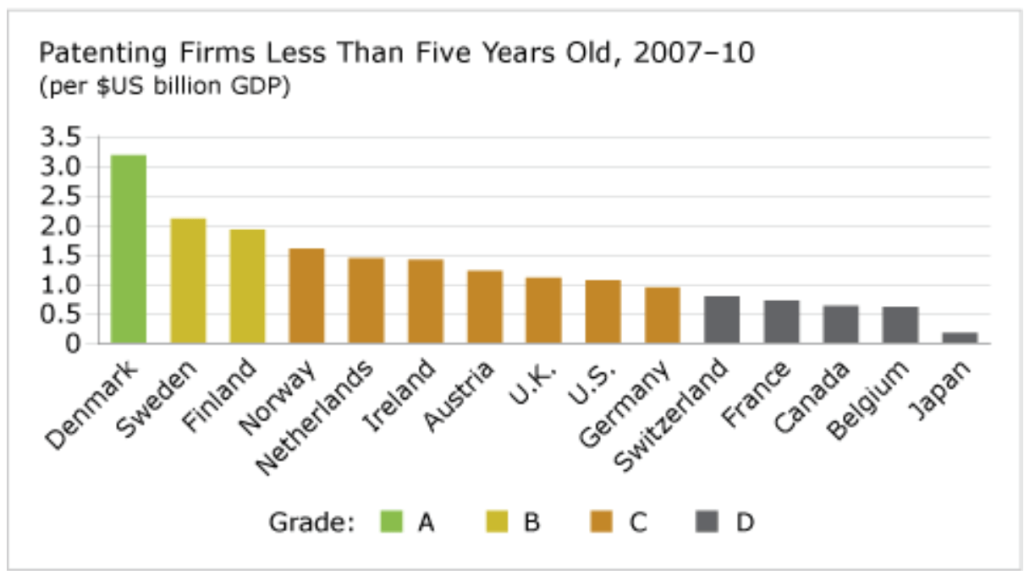Patenting Firms Less Than Five Years Old
Key Messages
- Entrepreneurship is recognized as an important factor behind innovation.
- Canada ranks 13th out of 15 peer countries, with “D” grade.
- Two of the three top-ranked countries—Denmark and Finland—benefit from comprehensive and focused government policies to boost entrepreneurship and innovation.

Why are patenting firms that are less than five years old important to innovation?
The OECD argues that “the presence of young firms among patent applicants underlines the inventive dynamics of firms early in their development and their desire to develop new activities and products; this may affect their survival and growth.”1
How does Canada’s performance on this indicator compare to its peers?
Canada ranks 13th out of 15 peer countries on this indicator, with a corresponding grade of “D.” Canada has 0.634 patenting firms less than five years old per billion dollars of GDP or, put another way, one firm for each $1.58 billion of GDP. Among the five countries with a “D,” Canada ranks behind Switzerland and France (11th and 12th place, respectively), but ahead of Belgium and Japan (14th and 15th place, respectively).
Who are the leaders on this indicator?
The three leaders are Denmark (an “A” performer), Sweden, and Finland (both graded “B”). Denmark and Finland are singled out by the OECD for their exceptional performance on this indicator. Notably, the Danish government’s three-pronged efforts to improve the country’s entrepreneurial climate—via a US$1-billion growth capital fund, a US$570-million loan guarantee scheme, and an entrepreneurship education strategy—are cited as examples.2 Third-place Finland also has a growing entrepreneurship culture, a robust venture capital industry, and a high proportion of young patenting firms that have probably benefited from the central government’s shift in focus toward small and medium-sized enterprises (SMEs).3 Second-place Sweden also benefits from a policy mix designed to boost entrepreneurship.4
What can Canada do to improve its grade on this indicator?
Entrepreneurship is recognized as an important factor behind innovation, but it is not clear what constitutes ideal conditions for boosting entrepreneurship.5 It is clear, however, that the outcome of entrepreneurship is positive for the entire economy.6
Canada has in place a number of measures to promote entrepreneurship. Notably, the OECD cites the improved SME access to Scientific Research & Experimental Development (SR&ED) tax credits, while venture capital from the Business Development Bank of Canada (BDC Venture Capital) helps and finances firms from seed to expansion. Export Development Canada (EDC) also provides private equity capital, through export finance guarantees, to help firms expand.7
However, the behaviour of firms themselves could be a problem. To wit, the federal government’s 2009 Survey of Innovation and Business Strategy reported that three out of four firms in Canada focused on either maintaining for exploiting the sales of their current goods and services, while only one in five focused on introducing new of significantly improved goods or services.8
In contrast, the European Union appears to have taken a more centralized and institutionalized approach to boosting entrepreneurship and innovation. Beginning in 2000, it implemented the Lisbon Agenda, with the explicit goal of making the EU the most competitive and dynamic knowledge-driven economy by 2010.9 This was followed in 2004 by a formal policy initiative to boost entrepreneurship. It set out five strategic policy areas to boost entrepreneurship—such as improving the flow of finance and creating a friendlier regulatory framework—along with a reporting mechanism to assess progress. This was followed in 2008 by the Small Business Act, which for the first time puts into place a comprehensive SME policy framework for the EU.
Innovation Indicators
Footnotes
1 OECD, “Patenting Firms,” in OECD Science, Technology and Industry Scoreboard 2011 (Paris: OECD, 2011), 186
2 OECD, OECD Science, Technology, and Industry Outlook 2012 (Paris: OECD, 2012), 278.
3 Ibid., 290.
4 A. Bornefalk and A. Du Rietz, Entrepreneurship Policies in Denmark and Sweden: Targets and Indicators (Lund: Swedish Network for European Studies in Economics and Business, April 2009), 7–8.
5 Ibid., 2.
6 E. Fisher, R. Reuber, C. Parsley, and S. Djukic, The State of Entrepreneurship in Canada (Ottawa: Industry Canada, 2010), 6–7.
7 OECD, OECD Science, Technology and Industry Outlook 2012 (Paris: OECD, 2012), 258.
8 Industry Canada, Highlights of the Survey of Innovation and Business Strategy (SIBS) 2009 (Ottawa: Industry Canada, 2010), 1.
9 European Union Commission, Action Plan: The European Agenda for Entrepreneurship (Brussels: EU Commission, 2004).

